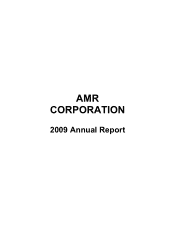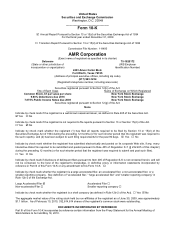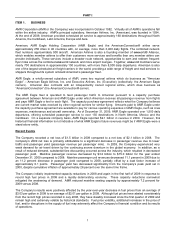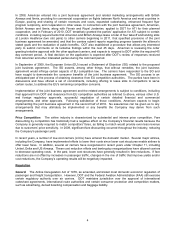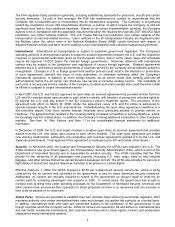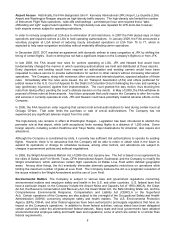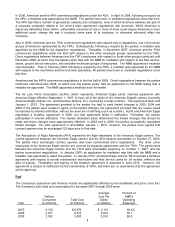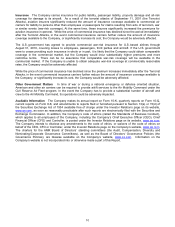American Airlines 2009 Annual Report Download - page 4
Download and view the complete annual report
Please find page 4 of the 2009 American Airlines annual report below. You can navigate through the pages in the report by either clicking on the pages listed below, or by using the keyword search tool below to find specific information within the annual report.
1
PART I
ITEM 1. BUSINESS
AMR Corporation (AMR or the Company) was incorporated in October 1982. Virtually all of AMR’s operations fall
within the airline industry. AMR's principal subsidiary, American Airlines, Inc. (American), was founded in 1934.
At the end of 2009, American provided scheduled jet service to approximately 160 destinations throughout North
America, the Caribbean, Latin America, Europe and Asia.
American, AMR Eagle Holding Corporation (AMR Eagle) and the AmericanConnection® airline serve
approximately 250 cities in 40 countries with, on average, more than 3,400 daily flights. The combined network
fleet numbers approximately 900 aircraft. American Airlines is also a founding member of oneworld® Alliance,
which enables member airlines to offer their customers more services and benefits than any member airline can
provide individually. These services include a broader route network, opportunities to earn and redeem frequent
flyer miles across the combined oneworld network and more airport lounges. Together, oneworld members serve
nearly 700 destinations in approximately 150 countries, with more than 8,000 daily departures. American is also
one of the largest scheduled air freight carriers in the world, providing a wide range of freight and mail services to
shippers throughout its system onboard American’s passenger fleet.
AMR Eagle, a wholly-owned subsidiary of AMR, owns two regional airlines which do business as "American
Eagle” – American Eagle Airlines, Inc. and Executive Airlines, Inc. (Executive) (collectively, the American Eagle
carriers). American also contracts with an independently owned regional airline, which does business as
“AmericanConnection” (the AmericanConnection® carrier).
The AMR Eagle fleet is operated to feed passenger traffic to American pursuant to a capacity purchase
agreement between American and AMR Eagle under which American receives all passenger revenue from flights
and pays AMR Eagle a fee for each flight. The capacity purchase agreement reflects what the Company believes
are current market rates received by other regional carriers for similar flying. Amounts paid to AMR Eagle under
the capacity purchase agreement are available to pay for various operating expenses of AMR Eagle, such as crew
expenses, maintenance and aircraft ownership. As of December 31, 2009, AMR Eagle operated over 1,500 daily
departures, offering scheduled passenger service to over 150 destinations in North America, Mexico and the
Caribbean. On a separate company basis, AMR Eagle reported $2.1 billion in revenue in 2009. However, this
historical financial information is not indicative of what AMR Eagle’s future revenues might be if AMR Eagle were a
stand-alone entity.
Recent Events
The Company recorded a net loss of $1.5 billion in 2009 compared to a net loss of $2.1 billion in 2008. The
Company’s 2009 net loss is primarily attributable to a significant decrease in passenger revenue due to lower
traffic and passenger yield (passenger revenue per passenger mile). In 2009, the Company experienced very
weak demand for air travel driven by the continuing severe downturn in the global economy. In addition, as a
result of reduced demand, substantial fare discounting occurred across the industry, which resulted in decreased
passenger yield. Mainline passenger revenue decreased by $3.2 billion to $15.0 billion for the year ended
December 31, 2009 compared to 2008. Mainline passenger unit revenues decreased 11.1 percent in 2009 due to
an 11.2 percent decrease in passenger yield compared to 2008, partially offset by a load factor increase of
approximately 0.1 points. Passenger yield has decreased significantly from the Company’s peak yield set in
2000, despite cumulative inflation of approximately 26 percent over the same time frame.
The Company initially implemented capacity reductions in 2008 and again in the first half of 2009 in response to
record high fuel prices in 2008 and a rapidly deteriorating economy. These capacity reductions somewhat
mitigated the weakening of demand. AMR reduced mainline seating capacity by approximately 7.2 percent for
2009 versus 2008.
The Company’s results were positively affected by the year-over-year decrease in fuel prices from an average of
$3.03 per gallon in 2008 to an average of $2.01 per gallon in 2009. Although fuel prices have abated considerably
from the record high prices recorded in July 2008, they have steadily increased since the first quarter of 2009 and
remain high and extremely volatile by historical standards. Fuel price volatility, additional increases in the price of
fuel, and/or disruptions in the supply of fuel may adversely affect the Company’s financial condition and its results
of operations.

